Battling against the current: The river governance puzzle we must solve

With Bangladesh's lifeblood—the rivers—choking under environmental degradation and legal entanglements, protecting these vital waterways has never been more daunting. The once straightforward task of river conservation now faces unprecedented challenges, requiring our Adviser for Environment, Forest, and Climate Change to untangle a web of outdated laws, unchecked pollution, and competing interests. Can we now rise to the occasion before our rivers run dry?
Recently, the Environment Adviser Syeda Rizwana Hasan remarked, "Strict enforcement of laws will be initiated for this purpose, and public cooperation is essential. Cost-effective plans will be developed to clean the rivers, and a campaign against polythene and plastic will be launched." Furthermore, on August 20, she announced that the Asian Development Bank (ADB) will assist Bangladesh in implementing low-cost river cleaning projects for key rivers, notably the Buriganga, Turag, and Balu. These are commendable initiatives, and Bangladesh is fortunate to have someone like Rizwana Hasan, who has championed river protection since the start of her career in 2003, notably suing shipbreaking yards in Chattogram, alongside entities involved in filling lakes for real estate, improper polythene usage, hill cutting, deforestation, unsustainable shrimp farming, and constructing illegal establishments on St Martin's Island.
However, the fight to protect our rivers and ensure environmental justice remains an uphill battle, complicated by the bureaucratic mess left by previous administrations. While the current direction shows promise, the implementation of these plans will require unwavering political will, accountability, and sustained public engagement. Without addressing the systemic issues that continue to hinder environmental governance, the journey towards restoring our rivers may remain fraught with obstacles.
During my two-year stint in the newsroom, starting in 2021, it was rare to go a day without encountering a story about river grabbing, pollution, over-dredging, or related legal issues. What struck me most was not the absence of initiatives, but rather that these initiatives consistently failed to yield results.
A typical report on river grabbing would go like this: the imminent seizure of a certain river has disrupted local lives. Fearful of retaliation from those backing the grab, locals would quietly mention that influential figures had taken over the land by either filling it with sand or marking riverbeds during the dry season. When questioned, Union Parishad members would often claim not to know about the matter but promise to look into it. The local chairman, meanwhile, would cite a lack of manpower for intervention. Occasionally, drives to halt the encroachment were conducted, but they either amounted to little more than window dressing, or officials themselves were pressured to turn a blind eye. As a result, the issue persisted, unresolved.
Then there were the pollution stories. Waste was regularly dumped into rivers due to a lack of city bins and timely waste collection, creating a generational habit of disposing of rubbish in waterways. Yet again, the blame would shift, with mayors pointing to manpower shortages or deflecting responsibility to other authorities.
Illegal dredging added another layer of complexity. Although dredging was often legally contracted through tenders, political favouritism dictated the selection process, as massive syndicates dominated the dredging industry. With private sector dredgers vastly outnumbering government resources, the Bangladesh Inland Water Transport Authority (BIWTA) would regularly issue tenders, allowing syndicates to bypass regulations. This unchecked activity led to the creation of sinkholes, further exacerbating river erosion.
These news stories inspired me to explore river governance in my thesis. I sought to understand why these problems had persisted for decades, seemingly impervious to changes in political leadership. After conducting a thorough analysis, it became clear that the issue runs deeper than mere politics—it's a systemic problem, maintained for both political and personal gain. Ultimately, even though the answer may seem quite obvious to many, I had to conclude that individuals, the state, and the broader international system alike are responsible for the dire state of our rivers.
Too many cooks spoil the broth

Bangladesh's water management framework is a classic example of how too many overlapping policies and authorities can lead to inefficiency and confusion. Two significant acts—the Bangladesh Water Act and the National River Protection Commission Act—were introduced in 2013. The Bangladesh Water Act, drafted by the Ministry of Water Resources (MoWR), was intended to provide an integrated approach to water resource management. Meanwhile, the National River Protection Commission (NRPC) Act aimed to safeguard rivers from illegal encroachments and pollution. However, these laws, though comprehensive on paper, exist alongside an overwhelming number of other policies related to water, including the Environment Conservation Act 1995, Coastal Zone Policy 2005, and National Forest Policy 1994.
To complicate matters further, water management falls under the jurisdiction of seven ministries and agencies, each with its own mandate. The Ministry of Water Resources is the primary regulator, while the Ministry of Environment and Forests monitors water resources. Ministries such as Agriculture, Local Government, and Disaster Management also hold critical roles as water users, leading to a fragmented and often contradictory approach with overlapping responsibilities. Previously, because of this premise, each department would shift the blame onto another.
The situation became more convoluted when, in 2019, the High Court declared rivers as legal entities and identified the National River Conservation Commission (NRCC) as the rivers' legal guardian. While the ruling was groundbreaking, its implementation remains stalled by overlapping responsibilities. The Ministry of Shipping, for instance, was tasked with river regulation, even though this should fall under the MoWR's jurisdiction, as outlined in the rules of business for different ministries.
Institutional gaps further exacerbate this lack of coordination among ministries. Water Resources Planning Organisation (WARPO), the agency responsible for implementing the Water Act, lacks clarity in its mandate, resources, and specialist personnel. The NRCC, intended to protect the rivers, is similarly constrained, needing the support of other ministries, such as the Ministry of Land for riverbank management and the Ministry of Shipping for waterway transportation.
What's most striking is the exclusion of the Ministry of Industry (MoI) from water governance, despite the industry being a significant water user and polluter. The absence of MoI, along with influential industry bodies like the Federation of Bangladesh Chambers of Commerce and Industry (FBCCI) and the Bangladesh Garment Manufacturers and Exporters Association (BGMEA), in decision-making processes leaves a critical gap. These sectors wield significant influence and must be involved in water planning, particularly in regulating industrial wastewater and water usage.
With multiple ministries, overlapping mandates, and the exclusion of key stakeholders, the great challenge for the new government is to streamline water governance so that decision-making in protecting rivers goes through fewer sieves of bureaucracy than the previous regime.
Buriganga: A glaring example of mismanaged water resource governance
The Buriganga River, once a lifeline of Dhaka, now stands as a testament to ineffective water resource management, despite legal frameworks aimed at its protection. The river is heavily polluted, and its potential is untapped beyond its use for transportation. Projects such as Bangladesh Inland Water Transport Authority's walkway initiative are steps forward, but the encroachment of the river continues, which necessitates behavioural change and alternative provisions for locals to ensure long-term success.
Long-term projects like the Buriganga River Restoration Project, initiated in 2010, still remain incomplete despite multiple extensions and soaring costs. The Covid-19 pandemic, delays in land acquisition, and permit approvals only added to the woes of this once-ambitious initiative.
Furthermore, the Bangladesh Water Act 2013 lacks a comprehensive approach which contributed to Buriganga's deterioration. While addressing water allocation and pollution, the Act fails to incorporate revenue management, community participation, and climate change mitigation. These omissions hinder sustainable water resource management and leave local communities out of critical decision-making processes.
Institutionally, little has been done to ensure coordination between various agencies, leaving the responsibilities of local government bodies and regulatory agencies unclear. This lack of clarity perpetuates inefficiency, with institutions passing on the blame for Buriganga's continued degradation. A decade of inaction from Dhaka Water Supply and Sewage Authority (WASA), despite numerous projects, only underscores the systemic issues at play.
As we grapple with these challenges, one must ask—are we truly committed to the restoration of our rivers, or have we grown too accustomed to merely managing their decline?
The way forward

Bangladesh's journey in managing water resources began with a heavy focus on flood control and boosting agriculture, as seen in the 1964 Water Master Plan. Since then, policies like the National Water Policy (1999) and the National Water Management Plan (2001) have sought to create a more integrated system, introducing concepts like Integrated Water Resource Management (IWRM) to streamline how water resources are handled across various sectors.
Fast forward to the Bangladesh Water Act (2013), which was meant to tie it all together, ensuring the sustainable use, protection, and development of the nation's water. Yet, water governance is currently structured like a patchwork quilt—each ministry and agency has a role, but no one seems to be working from the same script. The Ministry of Water Resources may be the primary regulator, but other heavy-hitters like the Ministry of Shipping and the Ministry of Land also have a say, creating confusion and diluting accountability.
Finally, there's the Bangladesh Delta Plan (BDP) 2100, which is an ambitious 100-year vision designed to address everything from flood protection to river sustainability. Yet with all the well-meaning policies and plans, there is a lack of coordination and clear leadership. As a result, we're not making the progress we need to.
To enhance river governance, Bangladesh must first focus on developing a more inclusive and iterative policymaking process. The current structure of centralised governance has been counterproductive in addressing on-the-ground issues, and as such, a more diversified approach is required. This should include greater community-based engagement to enable the government to respond more swiftly to pressing issues like flooding. By instituting robust feedback mechanisms for continual assessment and adaptation of policies, Bangladesh can respond more effectively to emerging challenges, refining its strategies based on real-world outcomes.
A key example of this iterative process is the Dutch "Policy Loop"—a cyclical approach to policymaking, where each phase of implementation is followed by an evaluation. It involves several stages: setting objectives, implementing policies, monitoring outcomes, and then revisiting and refining those policies based on feedback. This process enables governments to respond to real-time challenges and evolving conditions, ensuring that policies are not static but can be adapted as necessary. For Bangladesh, adopting a similar approach would provide more precise intervention points, allowing for a comprehensive strategy to address issues like encroachment, pollution, and displacement.
Simultaneously, Bangladesh needs to prioritise investment in strengthening the institutional capacities of municipal and district-level bodies. The success of the Netherlands in integrated water management practices and stakeholder engagement can offer valuable insights. The "Room for River" project, for example, provides a model of balancing river management with community needs. Adapting these models to suit Bangladesh's unique geographical and socio-economic conditions could significantly improve the effectiveness of our river governance.
Finally, developing an integrated policy framework that aligns river management with broader environmental, social, and economic objectives will ensure that river governance contributes positively to sustainable development. This would prioritise long-term sustainability and resilience, especially in the face of climate change.
Nazifa Raidah is a journalist, researcher and development practitioner. She can be reached at [email protected].
Views expressed in this article are the author's own.
Follow The Daily Star Opinion on Facebook for the latest opinions, commentaries and analyses by experts and professionals. To contribute your article or letter to The Daily Star Opinion, see our guidelines for submission.

 For all latest news, follow The Daily Star's Google News channel.
For all latest news, follow The Daily Star's Google News channel. 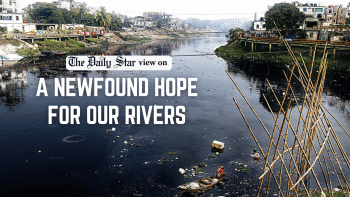

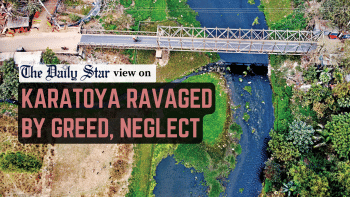
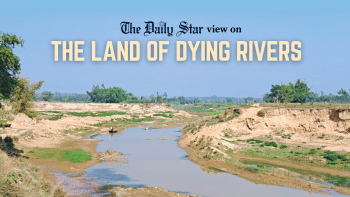


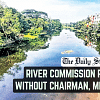



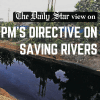


Comments